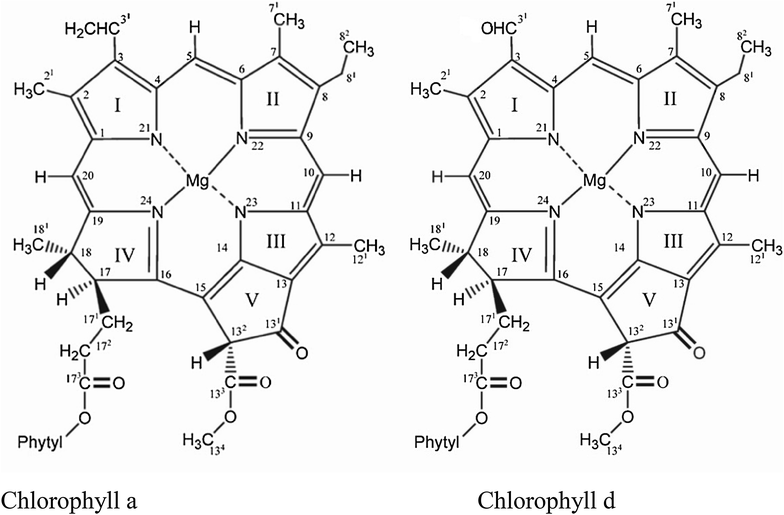Photosynthesis at the far-red region of the spectrum in Acaryochloris marina
- PMID: 28526061
- PMCID: PMC5438491
- DOI: 10.1186/s40659-017-0120-0
Photosynthesis at the far-red region of the spectrum in Acaryochloris marina
Abstract
Acaryochloris marina is an oxygenic cyanobacterium that utilizes far-red light for photosynthesis. It has an expanded genome, which helps in its adaptability to the environment, where it can survive on low energy photons. Its major light absorbing pigment is chlorophyll d and it has α-carotene as a major carotenoid. Light harvesting antenna includes the external phycobilin binding proteins, which are hexameric rods made of phycocyanin and allophycocyanins, while the small integral membrane bound chlorophyll binding proteins are also present. There is specific chlorophyll a molecule in both the reaction center of Photosystem I (PSI) and PSII, but majority of the reaction center consists of chlorophyll d. The composition of the PSII reaction center is debatable especially the role and position of chlorophyll a in it. Here we discuss the photosystems of this bacterium and its related biology.
Keywords: Acaryochloris species; Chlorophyll d; Oxygenic photosynthesis; P740; Photosystem; Phycobillisomes.
Figures
Similar articles
-
Niche adaptation and genome expansion in the chlorophyll d-producing cyanobacterium Acaryochloris marina.Proc Natl Acad Sci U S A. 2008 Feb 12;105(6):2005-10. doi: 10.1073/pnas.0709772105. Epub 2008 Feb 5. Proc Natl Acad Sci U S A. 2008. PMID: 18252824 Free PMC article.
-
Chlorophyll d and Acaryochloris marina: current status.Photosynth Res. 2013 Oct;116(2-3):277-93. doi: 10.1007/s11120-013-9829-y. Epub 2013 Apr 25. Photosynth Res. 2013. PMID: 23615924 Review.
-
Structure of the far-red light utilizing photosystem I of Acaryochloris marina.Nat Commun. 2021 Apr 20;12(1):2333. doi: 10.1038/s41467-021-22502-8. Nat Commun. 2021. PMID: 33879791 Free PMC article.
-
Impact of energy limitations on function and resilience in long-wavelength Photosystem II.Elife. 2022 Jul 19;11:e79890. doi: 10.7554/eLife.79890. Elife. 2022. PMID: 35852834 Free PMC article.
-
Unique photosystems in Acaryochloris marina.Photosynth Res. 2008 Oct-Dec;98(1-3):141-9. doi: 10.1007/s11120-008-9383-1. Epub 2008 Nov 5. Photosynth Res. 2008. PMID: 18985431 Review.
Cited by
-
Advances in Genetic Engineering in Improving Photosynthesis and Microalgal Productivity.Int J Mol Sci. 2023 Jan 18;24(3):1898. doi: 10.3390/ijms24031898. Int J Mol Sci. 2023. PMID: 36768215 Free PMC article. Review.
References
-
- Miyashita H, Ikemoto H, Kurano N, Adachi K, Chihara M, Miyachi S. Chlorophyll d as a major pigment. Nature. 1996;383:402. doi: 10.1038/383402a0. - DOI
Publication types
MeSH terms
Substances
LinkOut - more resources
Full Text Sources
Other Literature Sources


